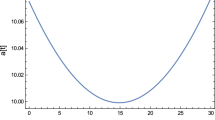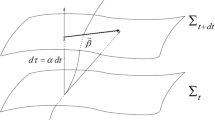Abstract
Gravitational falling in the Anti-deSitter Spacetime (AdS) has two characteristic properties: i) A thick shell becomes a thin shell. ii) Any shape become spherical. Such a focusing character of the AdS space, for collapse of dust clouds, leads to the rapid thermalization mechanism in strongly interacting system. For a conformally flat boundary, we show that such focusing mechanism is universal in all known background geometries of D-branes as well as in those of AdS spacetime. We calculate the time scale for thermalization in terms of the total mass density and the lowest upper bound of the energy distribution of the initial particles. We find t th ~ (1 − c 1/E 2)1/2/T, which is less than the typical collision time so that softer modes thermalize first. We also suggest that the same idea can shed light on the collapse of waves belonging the heavy numerical relativity.
Similar content being viewed by others
References
U. W. Heinz and P. F. Kolb, Nucl. Phys. A 702, 269 (2002) [hep-ph/0111075].
J. M. Maldacena, Adv.Theor.Math.Phys. 2 (1998) 231–252, [hep-th/9711200].
E. Shuryak, S.-J. Sin and I. Zahed, J. Korean Phys. Soc. 50, 384 (2007) [hep-th/0511199].
U. H. Danielsson, E. Keski-Vakkuri and M. Kruczenski, JHEP 0002, 039 (2000) [hep-th/9912209].
V. Balasubramanian, A. Bernamonti, J. de Boer, N. Copland, B. Craps, E. Keski-Vakkuri, B. Muller and A. Schafer et al., Phys. Rev. D 84, 026010 (2011) [arXiv:1103.2683 [hep-th]].
S. Bhattacharyya and S. Minwalla, [arXiv:0904.0464 [hep-th]].
P. M. Chesler and L. G. Yaffe, Phys. Rev. Lett. 99, 152001 (2007) [arXiv:0706.0368 [hep-th]].
R. A. Janik and R. B. Peschanski, Phys. Rev. D 73, 045013 (2006) [hep-th/0512162].; M. P. Heller, R. A. Janik and P. Witaszczyk, Phys. Rev. Lett. 108, 201602 (2012) [arXiv:1103.3452 [hep-th]].; S. Nakamura and S. -J. Sin, JHEP 0609, 020 (2006) [hep-th/0607123].; S. -J. Sin, S. Nakamura and S. P. Kim, JHEP 0612, 075 (2006) [hep-th/0610113].
P. Bizon and A. Rostworowski, Phys. Rev. Lett. 107, 031102 (2011) [arXiv:1104.3702 [gr-qc]].
O. J. C. Dias, G. T. Horowitz and J. E. Santos, Class. Quant. Grav. 29, 194002 (2012) [arXiv:1109.1825 [hepth]].
D. Garfinkle and L. A. Pando Zayas, Phys. Rev. D 84, 066006 (2011) [arXiv:1106.2339 [hep-th]]; D. Garfinkle, L. A. Pando Zayas and D. Reichmann, JHEP 1202, 119 (2012) [arXiv:1110.5823 [hep-th]].
A. Buchel, L. Lehner and S. L. Liebling, Phys. Rev. D 86, 123011 (2012) [arXiv:1210.0890 [gr-qc]].
H. Bantilan, F. Pretorius and S. S. Gubser, Phys. Rev. D 85, 084038 (2012) [arXiv:1201.2132 [hep-th]].
A. Adams, P. M. Chesler and H. Liu, [arXiv:1212.0281 [hep-th]].
E. Oh and S. -J. Sin, [arXiv:1302.1277 [hep-th]].
J. Polchinski and M. J. Strassler, Phys. Rev. Lett. 88, 031601 (2002) [hep-th/0109174].
S.-J. Sin, Phys. Rev. D 50, 3650 (1994) [hepph/9205208].
Simulation movie by Rostworowski available at http://lackholes.ist.utl.pt/nrhep2/Downloads/Rostworowski NRHEP2 notebooks.zip
A. Zee, “Quantum field theory in a nutshell,” Princeton, UK: Princeton Univ. Pr. (2010), p. 576.
K. Huang, “Quantum field theory: From operators to path integrals” New York, USA: Wiley (1998), p. 426.
F. Pretorius and M. W. Choptuik, Phys. Rev. D 62, 124012 (2000) [gr-qc/0007008].
B. Wu, JHEP 1210, 133 (2012) [arXiv:1208.1393 [hepth]].
A. Ayala, S. Jeon and J. I. Kapusta, Phys. Rev. C 59, 3324 (1999) [nucl-th/9807062].
F. Carrasco, L. Lehner, R. C. Myers, O. Reula and A. Singh, Phys. Rev. D 86, 126006 (2012) [arXiv:1210.6702 [hep-th]].
A. Adams, P. M. Chesler and H. Liu, [arXiv:1307.7267 [hep-th]].
S. R. Green, F. Carrasco and L. Lehner, [arXiv:1309.7940 [hep-th]].
C.-K. Chan, D. Mitra and A. Brandenburg, Phys. Rev. E 85, 036315 (2012).
Author information
Authors and Affiliations
Corresponding author
Rights and permissions
About this article
Cite this article
Sin, SJ. Physical mechanism of AdS instability and universality of holographic thermalization. Journal of the Korean Physical Society 66, 151–157 (2015). https://doi.org/10.3938/jkps.66.151
Received:
Accepted:
Published:
Issue Date:
DOI: https://doi.org/10.3938/jkps.66.151




